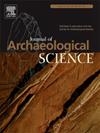烟草使用的生物考古学:牙本质中尼古丁和可替宁检测的探索性研究
IF 2.5
1区 地球科学
Q1 ANTHROPOLOGY
引用次数: 0
摘要
纵观历史,烟草使用在人群中一直很明显。然而,通过人体骨骼遗骸中尼古丁和可替宁等代谢物的存在来检测烟草使用是具有挑战性的,因为这些分子会随着时间的推移而分解和损失。本研究试图从考古背景下的骨骼遗骸中检测牙本质中的烟草使用。将先前发表的非靶向方法(Badillo-Sanchez et al., 2023b)应用于分析牙本质的靶向方法,从奥地利拿破仑战场(1809年)出土的5具骨骼中提取了8个牙本质样本。所有五个人都有烟草使用的外部迹象(例如,烟斗面和烟草染色)。来自吸烟者的现代牙本质样本和来自欧洲前烟草时期(6 -9世纪)的考古样本也分别作为阴性和阳性对照进行了测试。提取和纯化后,用液相色谱系统直接耦合串联质谱分析。在所有的考古牙齿中都没有检测到尼古丁。在一个阳性对照样本中也发现了在信号噪声水平以上检测尼古丁的困难,这可能与尼古丁在体内的半衰期有关。另一方面,在19世纪早期的五个样本中的一个样本和所有三个现代对照样本中都发现了可替宁。这表明牙本质是考古代谢组学研究的可靠来源,而可替宁在过去的烟草使用调查中可以作为目标代谢物。本文章由计算机程序翻译,如有差异,请以英文原文为准。
The bioarchaeology of tobacco use: An exploratory study of nicotine and cotinine detection in tooth dentine
Tobacco use has been evident in human populations throughout history. However, the detection of tobacco usage through the presence of metabolites, such as, nicotine and cotinine, in human skeletal remains is challenging due to the breakdown and loss of these molecules over time. This research attempts to detect tobacco use from dentine in skeletal remains from an archaeological context. Adapting a previously published untargeted method (Badillo-Sanchez et al., 2023b) to a targeted approach for analysing dentine, eight tooth dentine samples were extracted from five skeletons excavated from a Napoleonic battlefield (1809) in Austria. All five individuals had external signs of tobacco use (e.g., pipe facets and tobacco staining). Modern dentine samples from tobacco smokers and archaeological samples from the pre-tobacco period (6th-9th century) in Europe were also tested as negative and positive controls, respectively. After extraction and purification, the extracts were analysed using a liquid chromatography system directly coupled to a tandem mass spectrometer. Nicotine was not detected in any of the archaeological teeth. Difficulties of nicotine detection above the signal-to-noise levels were also seen in one of the positive control samples and could be linked to the half-life of nicotine in the body. On the other hand, cotinine was identified in one of the five samples from the early 19th century and in all three modern control samples.
This indicates that tooth dentine is a reliable source for archaeometabolomic studies, and cotinine can be a targeted metabolite in investigations of tobacco use in the past.
求助全文
通过发布文献求助,成功后即可免费获取论文全文。
去求助
来源期刊

Journal of Archaeological Science
地学-地球科学综合
CiteScore
6.10
自引率
7.10%
发文量
112
审稿时长
49 days
期刊介绍:
The Journal of Archaeological Science is aimed at archaeologists and scientists with particular interests in advancing the development and application of scientific techniques and methodologies to all areas of archaeology. This established monthly journal publishes focus articles, original research papers and major review articles, of wide archaeological significance. The journal provides an international forum for archaeologists and scientists from widely different scientific backgrounds who share a common interest in developing and applying scientific methods to inform major debates through improving the quality and reliability of scientific information derived from archaeological research.
 求助内容:
求助内容: 应助结果提醒方式:
应助结果提醒方式:


